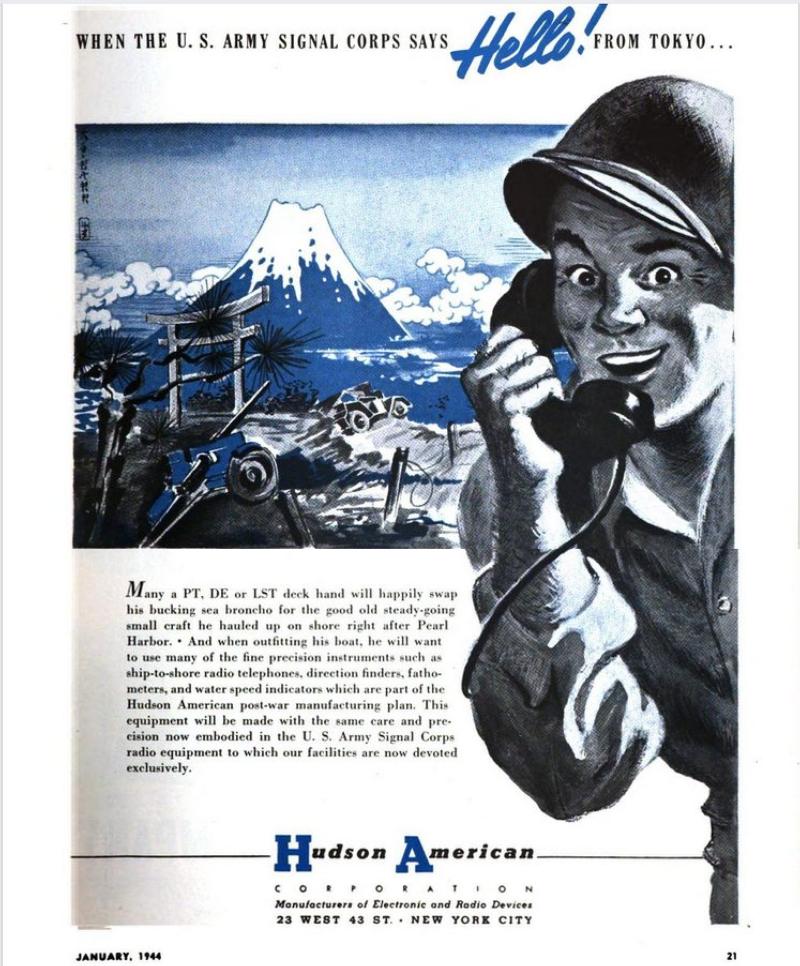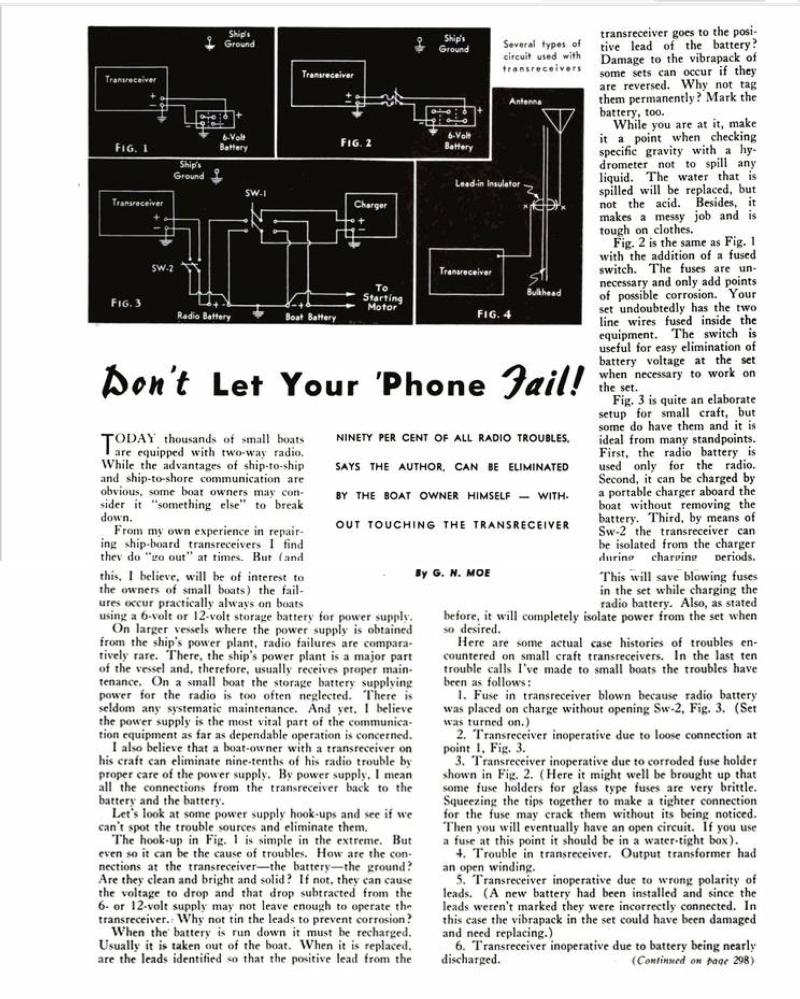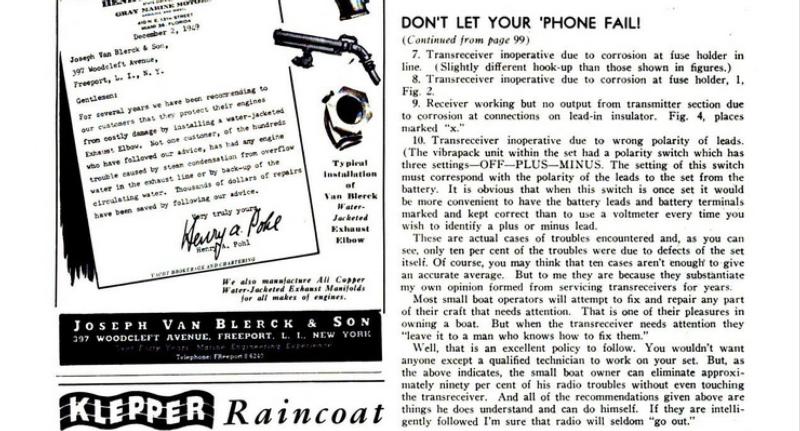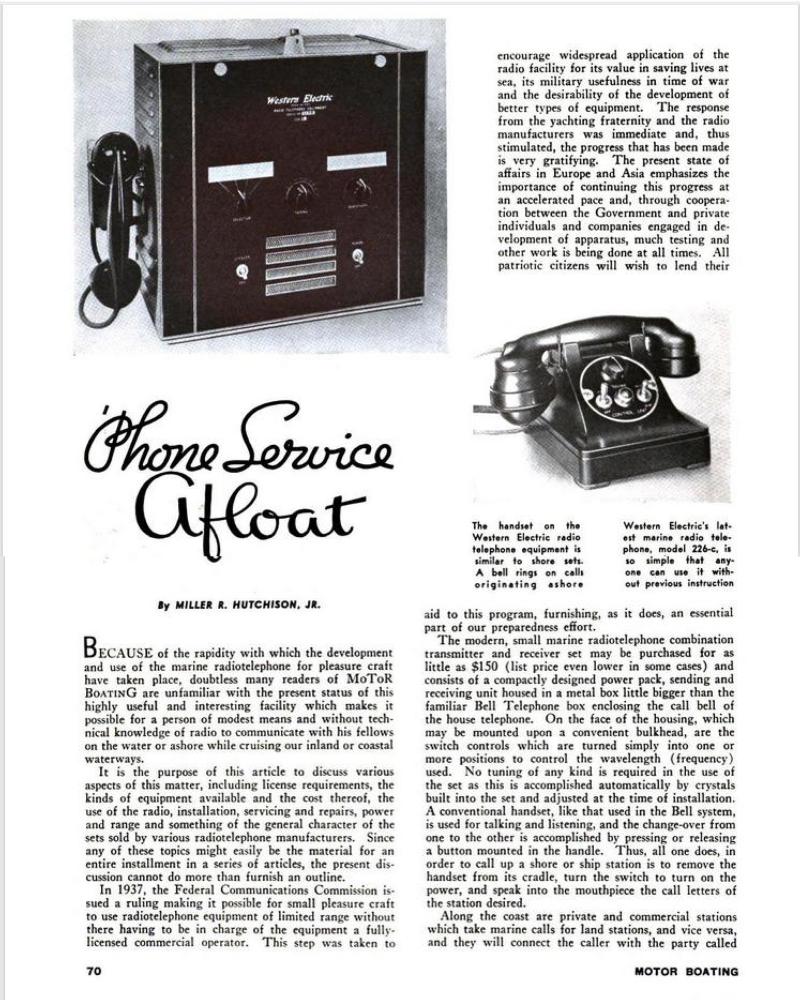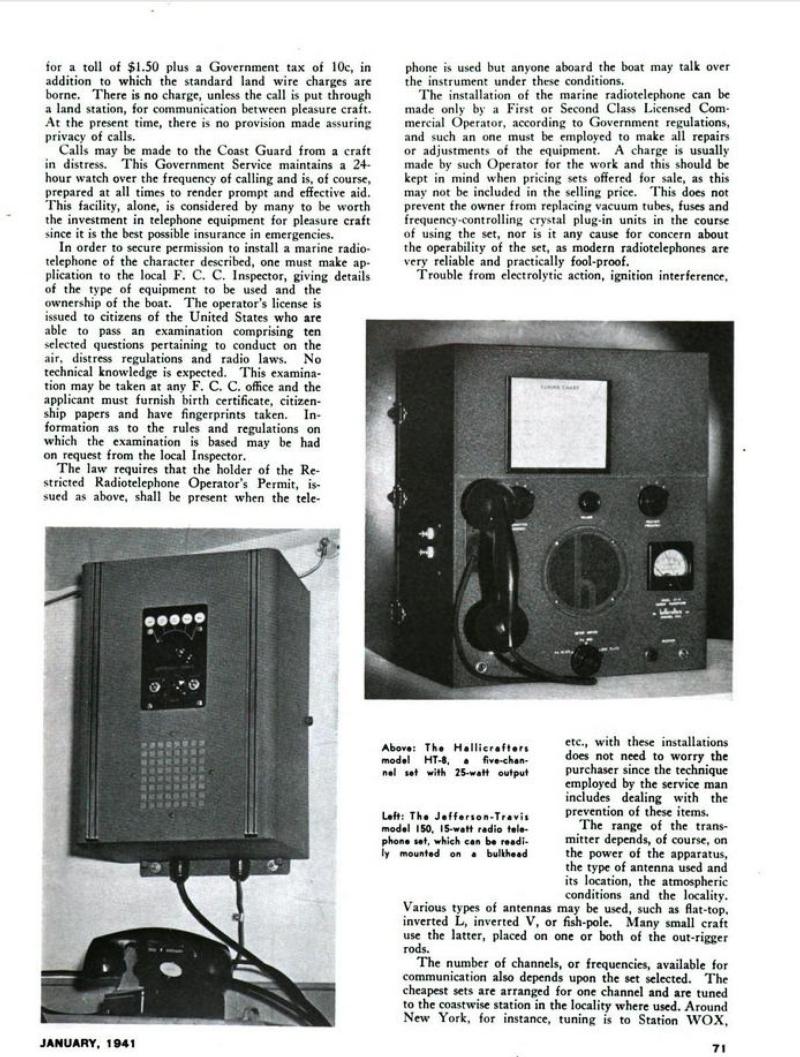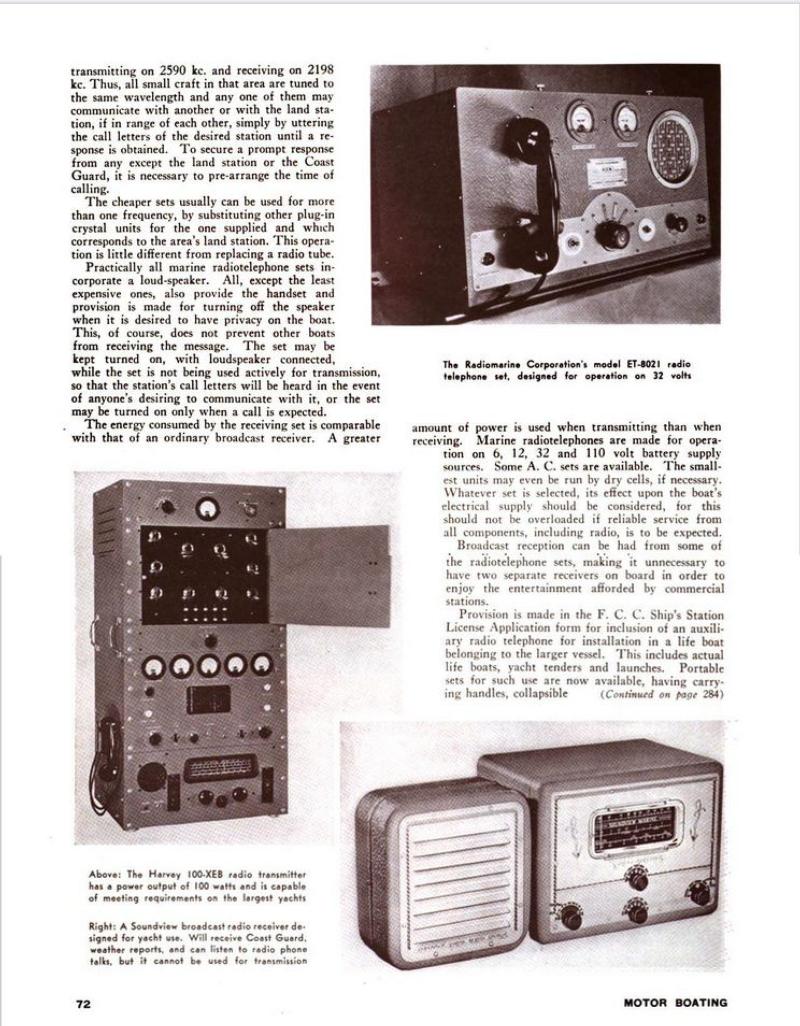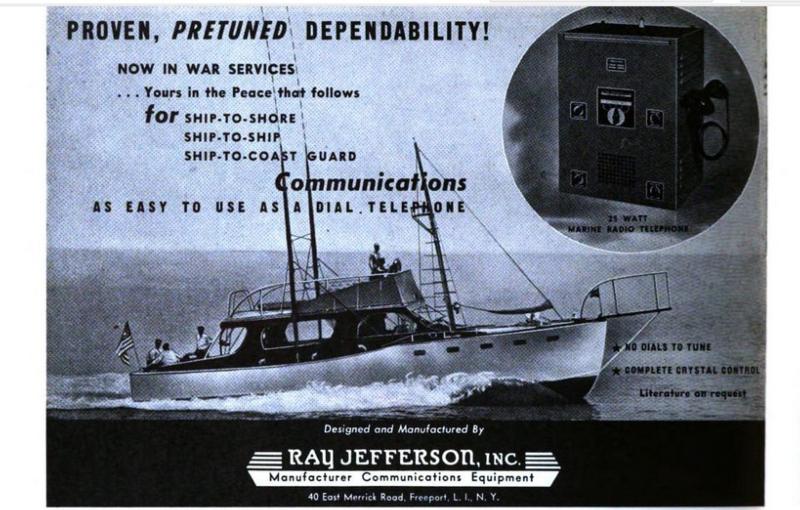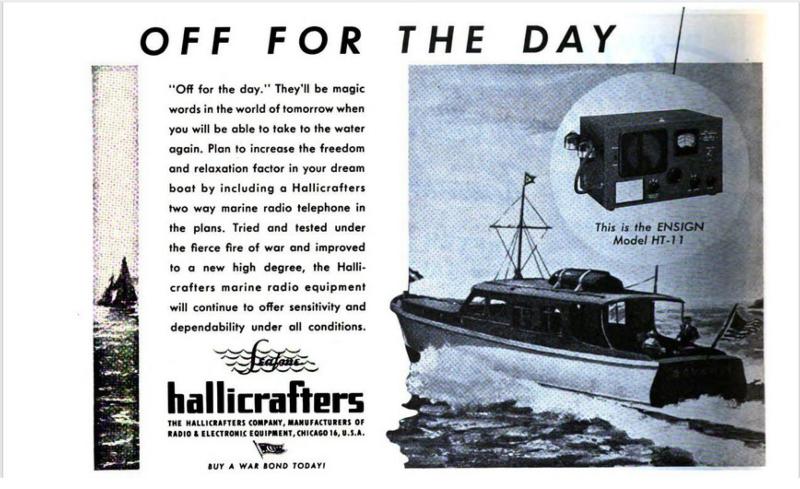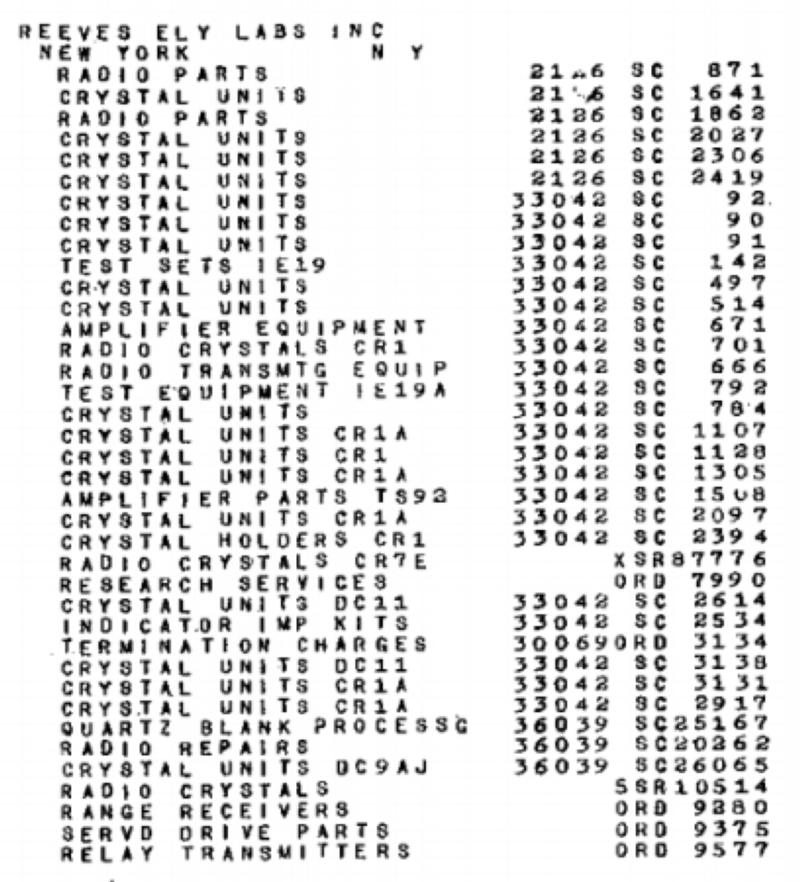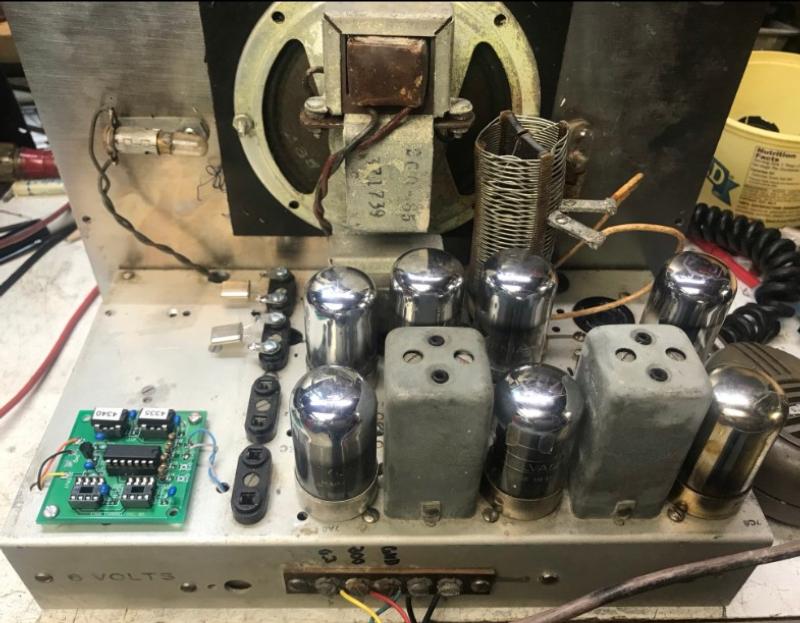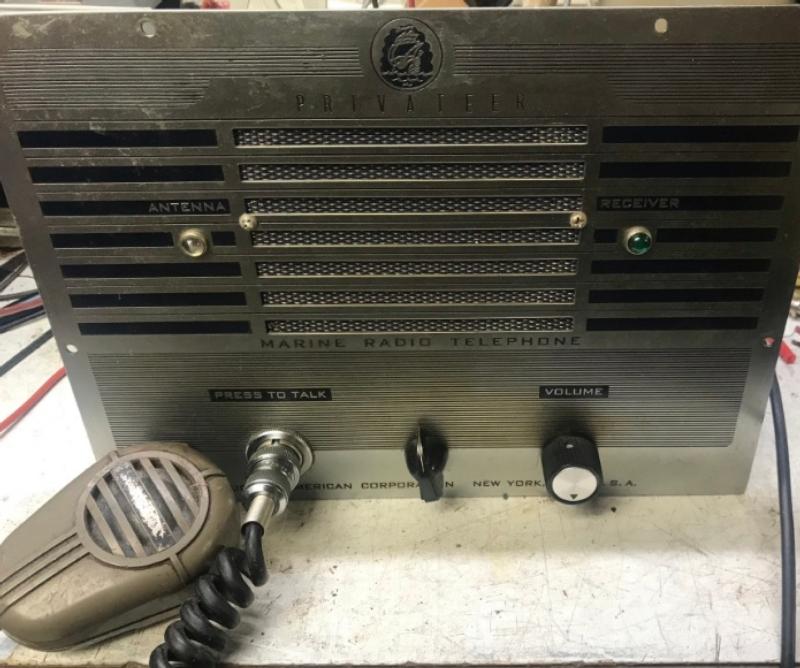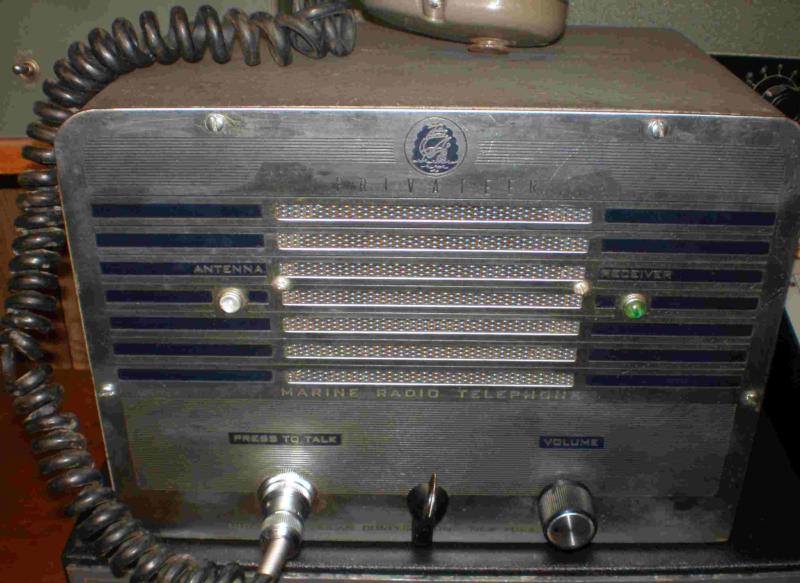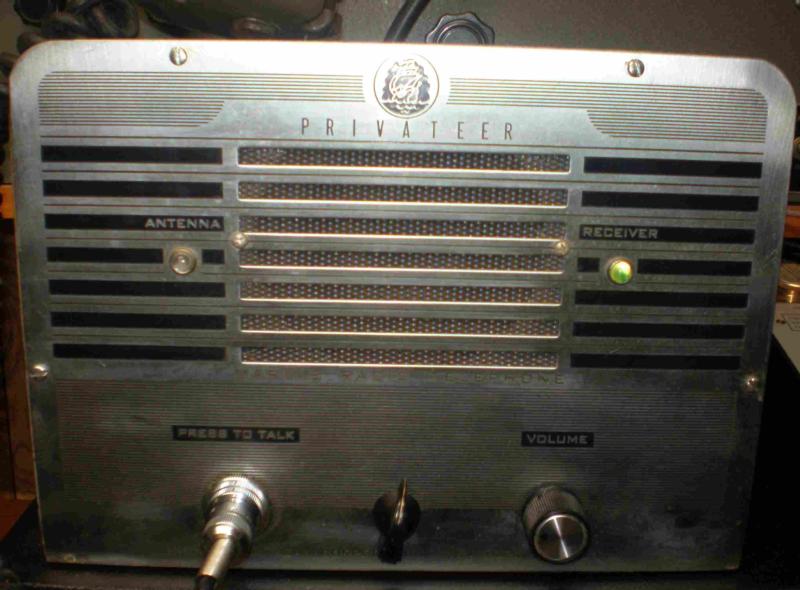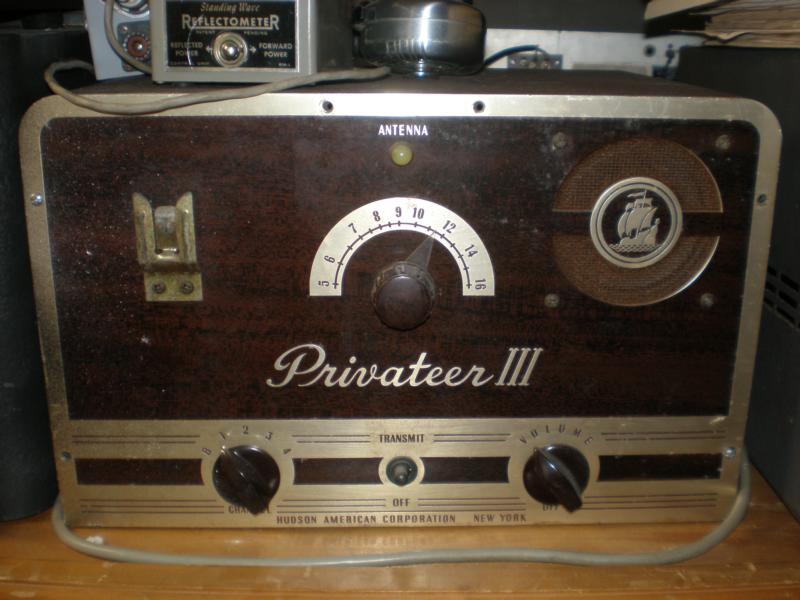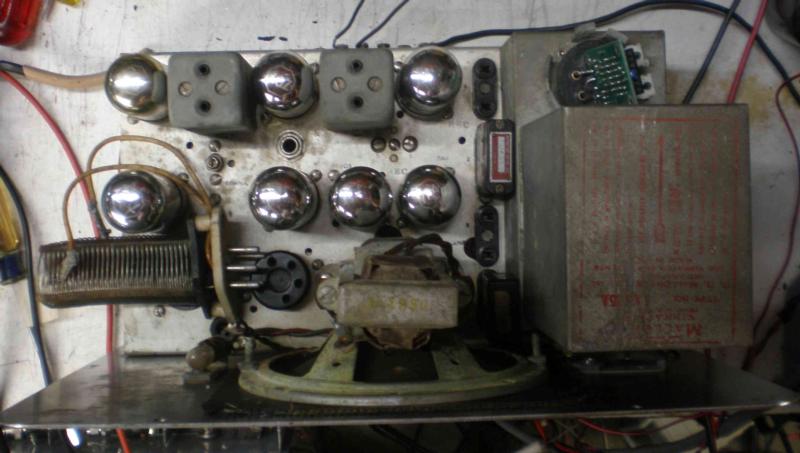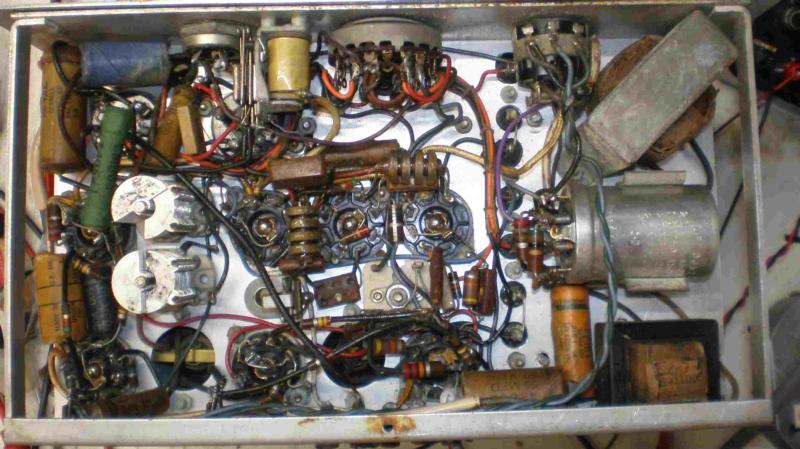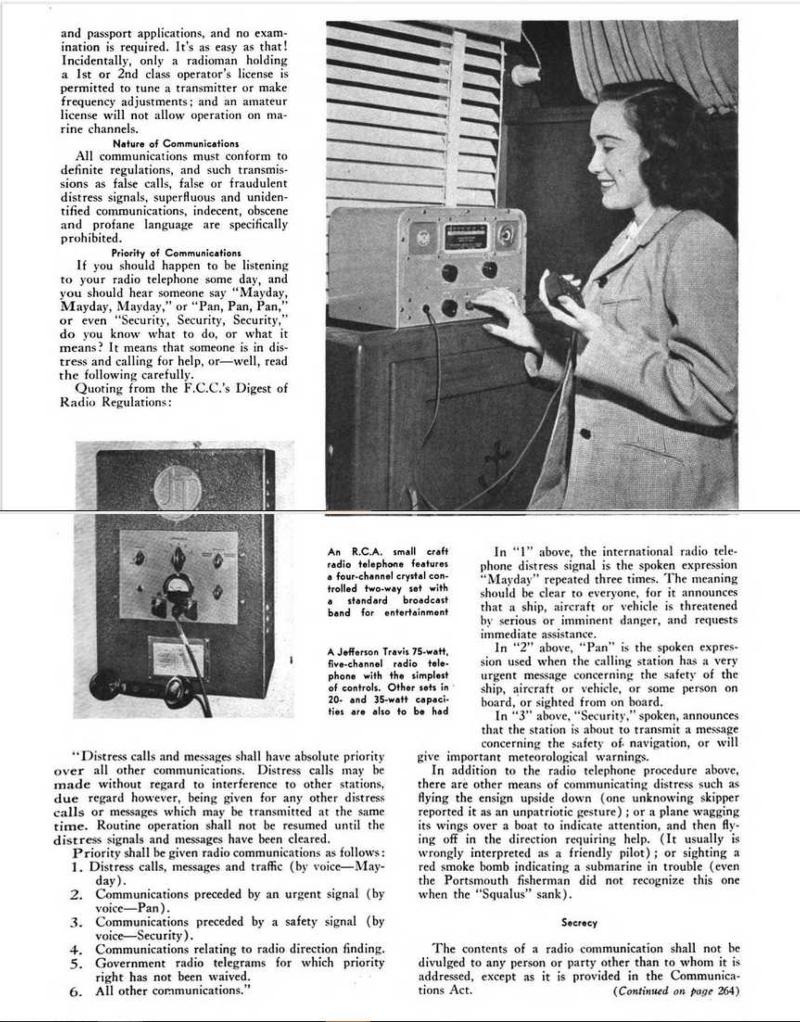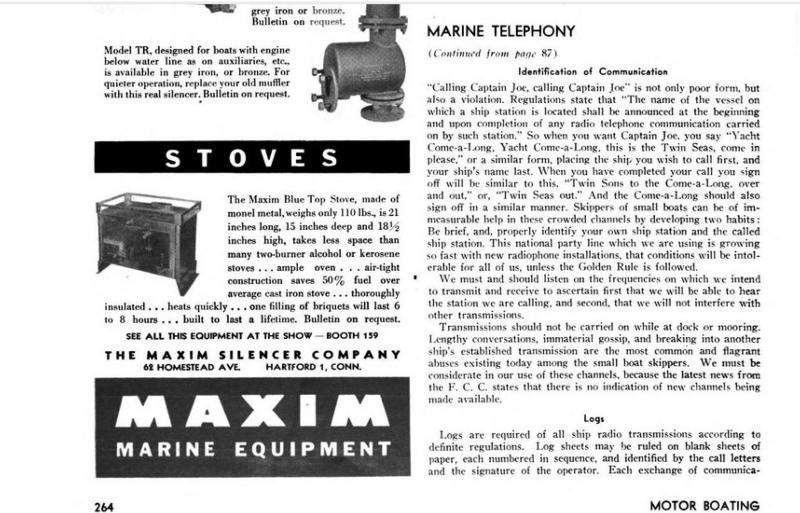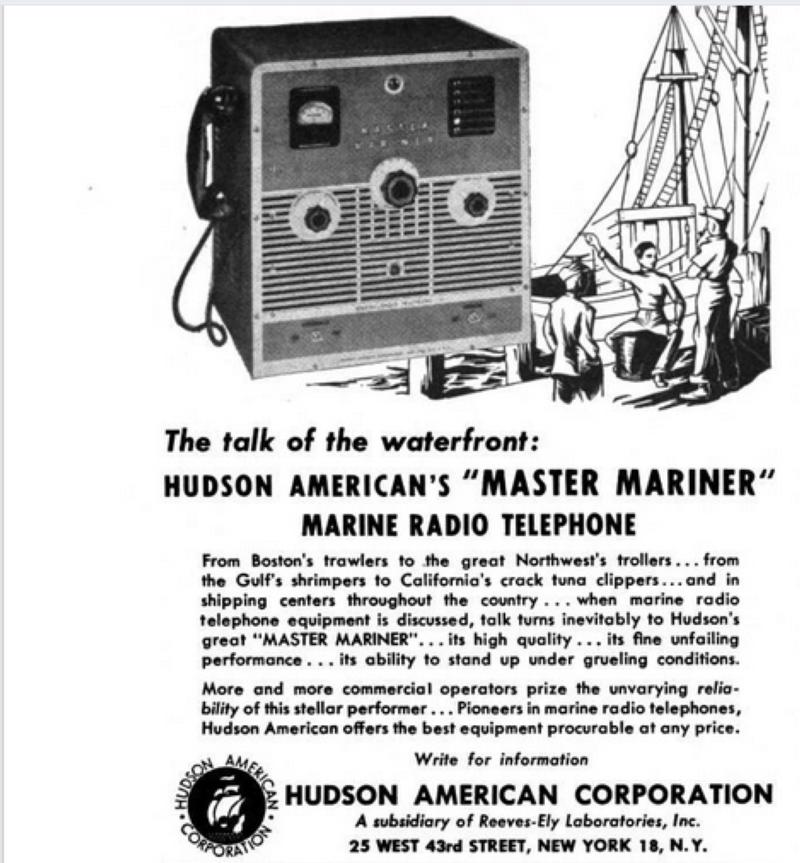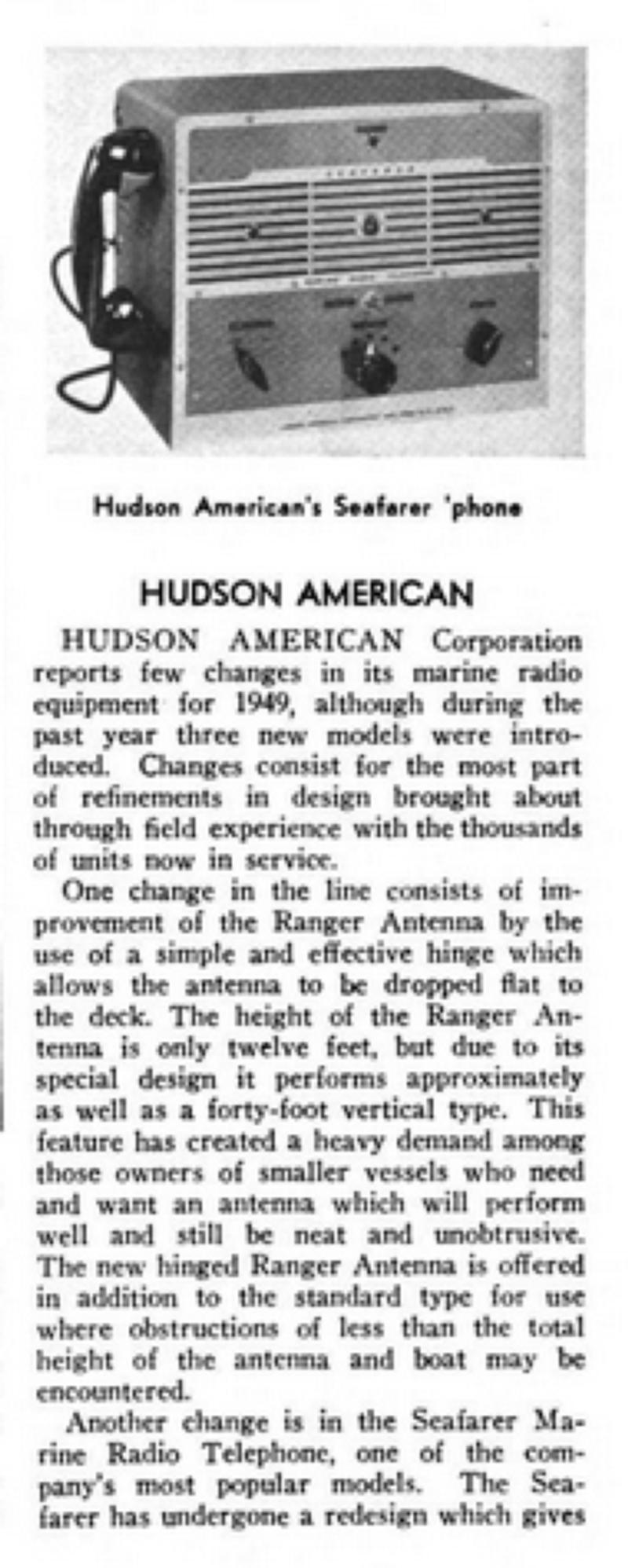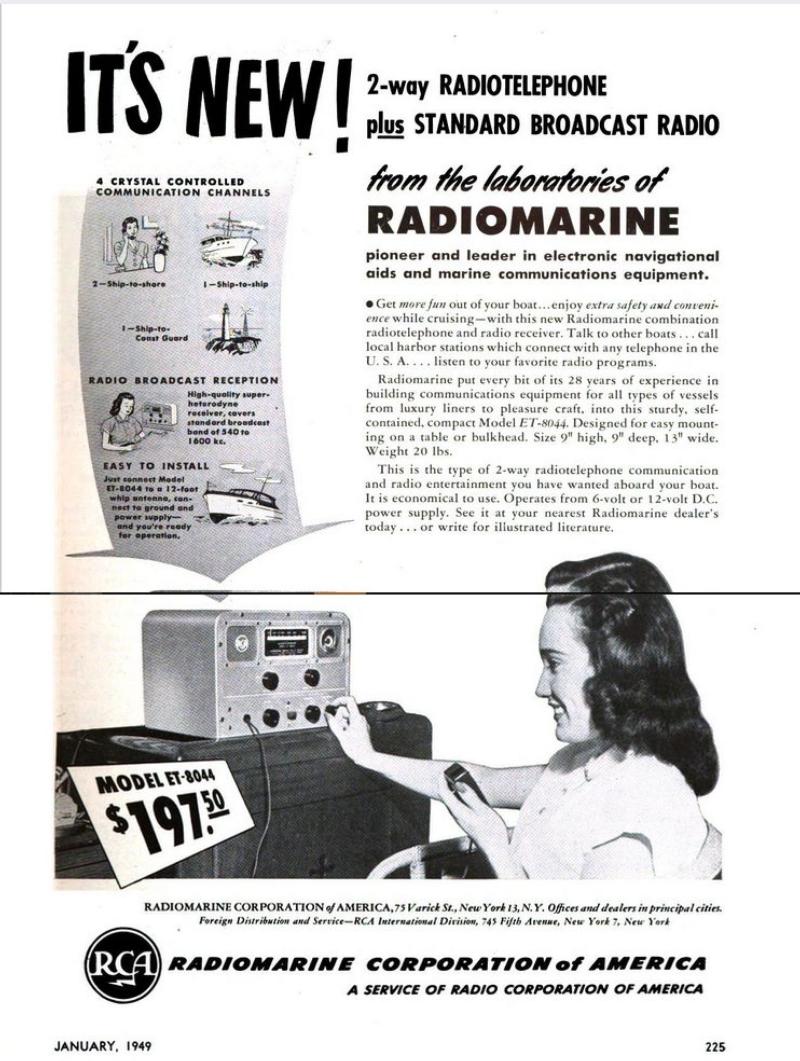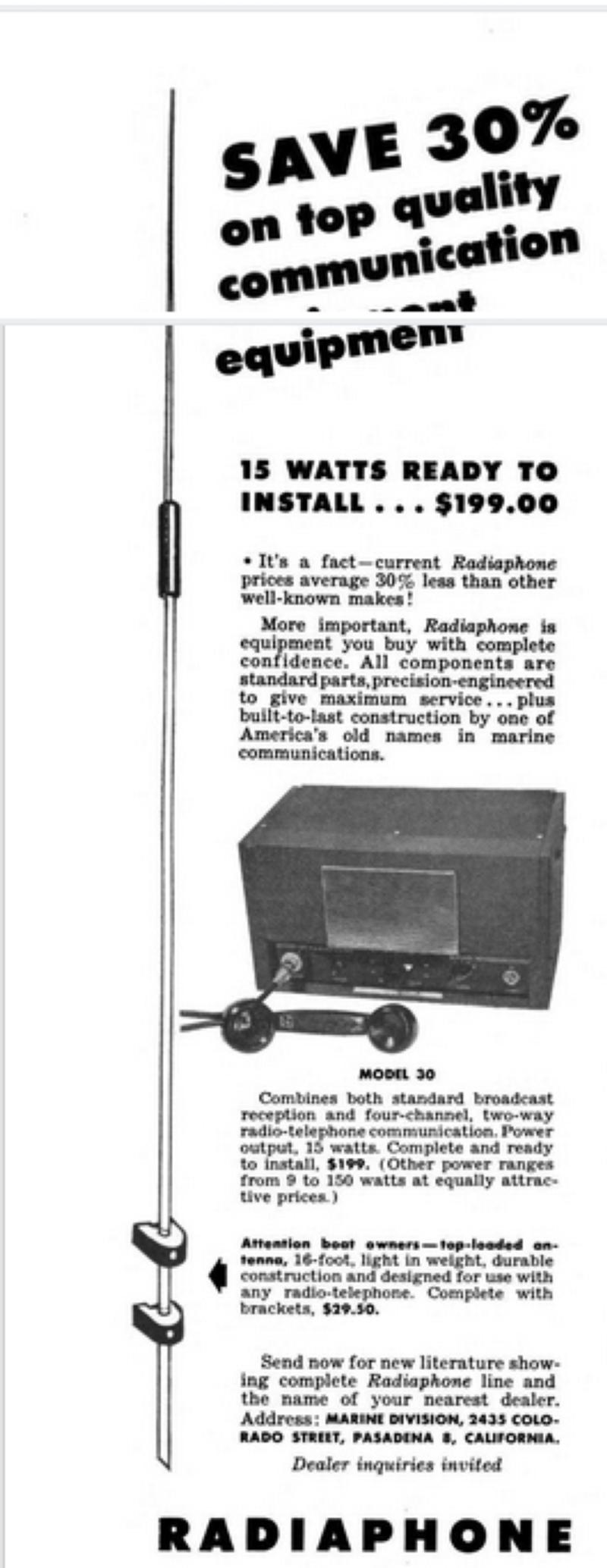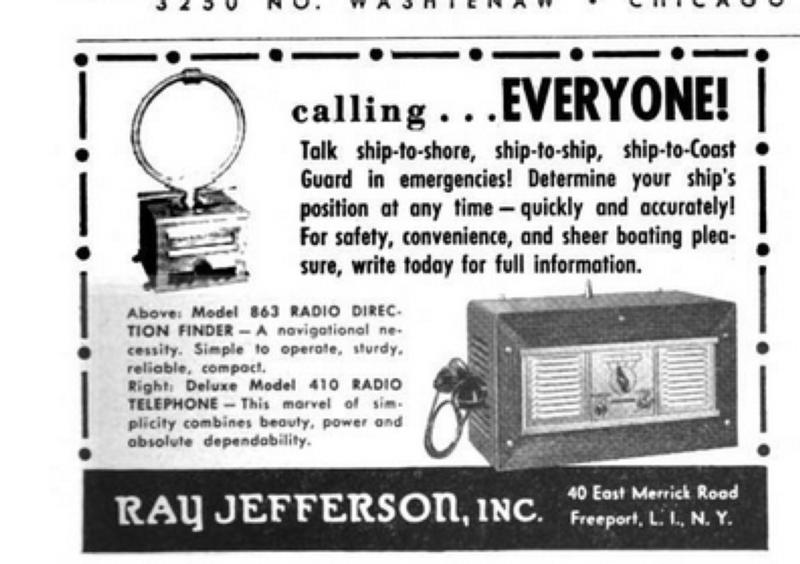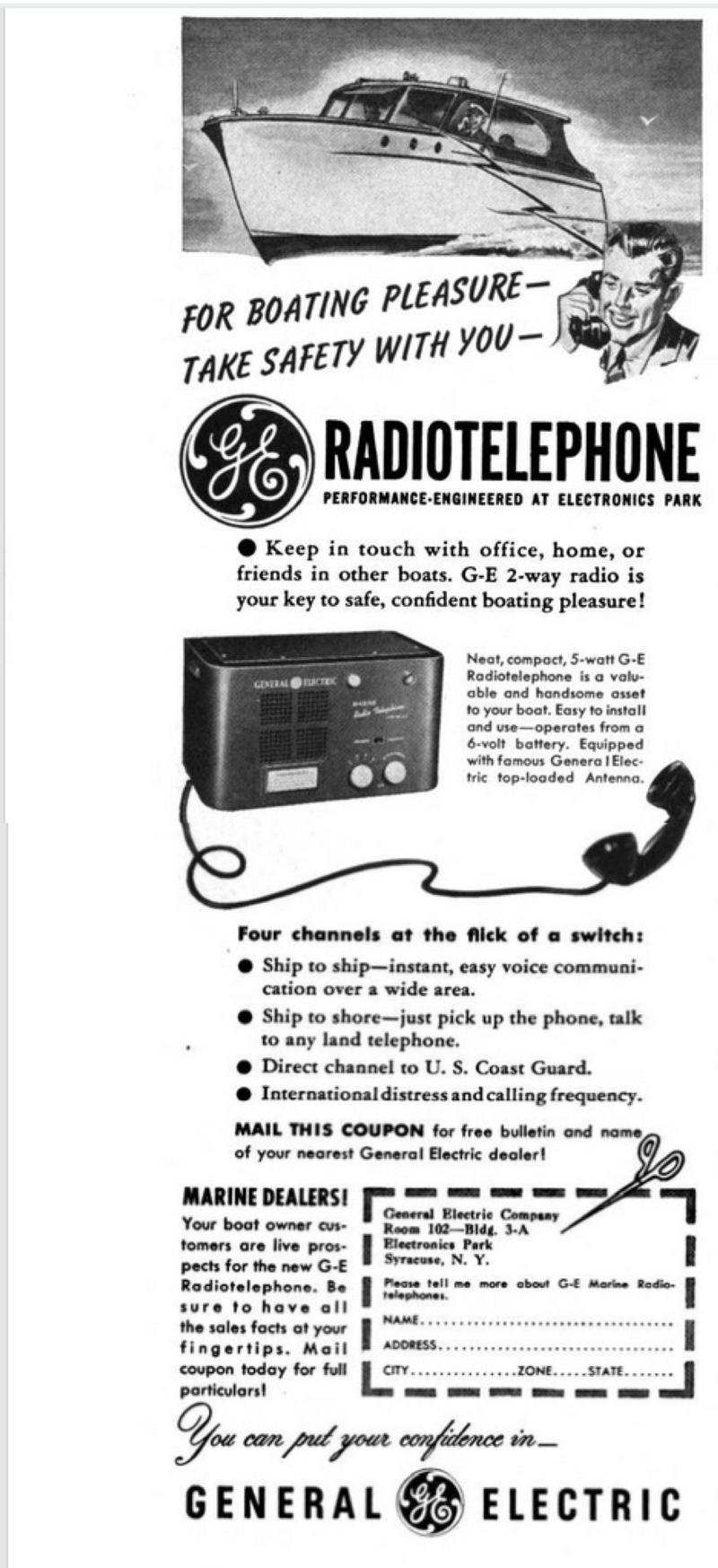
Posted By: Robert Nickels (ranickels) Posted: 05/02/2021 Vintage Radio 05/02/2021 |
Hudson American CorporationManufacturer of marine radios in the 1940s |
|
I enjoy playing with old marine radios that operated in the AM mode between 2-3 MHz. This was the standard for "ship to shore" radio and telephone service from marine radio operators from after WWII until about 1970 when SSB was phased in and AM became obsolete. Through this era a number of manufacturers were major players including RCA (Radiomarine), Raytheon (Apelco), Ray Jefferson, Sonar, Hallicrafters, Bendix, and a number of others. But one company stands out for me, not only because it was only a participant early and then disappeared, but because it's radios were the prettiest in terms of styling. They even advertized them as "the aristocrats of marine radio'. That company is Hudson American Corporation of 25 West 43rd St. in New York City. The building at that address still exists, home to fast food joints on the ground floor, and only a few blocks from Times Square and the Broadway theater district. Clearly Hudson American occupied a prestigious address even back then in the heart of America's largest city. Time were good, the post-war boom in consumer spending in the US stimulated production of luxury items like motorboats for those who could afford them. A 20-25 foot cabin cruiser could be had for between 3 and 6 thousand dollars, ("and up", of course). That was still an enormous amount of money in 1949 when the average family income was $3100, but for some of those on the high side of the average who lived near water, sailing and power boating were among the top "cool things to do". And what well-heeled boat owner would not want to equip his cruiser with the latest conveniences, especially two-way radio and telephone communications? I have two Hudson American marine radiotelephones, both versions of the "Privateer" model which was at the bottom of the line. Still, the styling and appearance puts other models to shame, even those from the giant RCA's Radiomarine division. Hudson American's ads mention the influence of the best industrial designers which is a cost that many radio manufacturers opted not to incur. But it was a smart decision, knowing their product would have to appeal to buyers who could affort a boat or yacht were discriminating buyers and thus had a taste for "the finer things". The Privateer II with it's faux-wood panel would look right at home in an expensive boat. Even the entry-level Privateer features a stainless steel panel that not only looked good but was able to resist the effects of salt water so it would stay that way. These were simple radios with as few as two channels although the bigger model did provide for AM BC reception. I try different methods of conversion to the ham bands and in this one, I modified the tuning range so it can tune a section of the 80 meter band. Transmitter frequency is crystal controlled on 3880 or 3885 KHz. In the smaller Privateer shown I have kept the Mallory 6 volt Vibrapack that generates the 300 volt B+ but have installed one of my FET replacements and a full-wave rectifier instead of the synchronous vibrator which chopped the DC so it could be stepped-up, then also rectified the AC output. It was a clever way to obtain high voltage DC but was fraught with failure modes and RF noise. The Privateer receiver is a 4-tube superhet using loktal tubes. The transmitter consists of an oscillator and two 7C5 output tubes with another 7C5 for receive audio and modulator. The complexity in these radios always comes from the channel selection method, in this case a multi deck 2 position switch selected between two channels, each with it's own tuning adjustments for the rx and tx. Output power ranged from 5 watts up to 30 or so in the more expensive radios, but even when matched to a short antenna that was sufficient to maintain communications with the high-powered shore station with normal cruising range, and with other nearby boats. Since there is no longer any traffic on the 2-3 MHz band, nothing is lost by converting these radios for use on the amateur 80 and 160 meter bands where low-power AM is still feasible, and that's what I'll be doing with the latest Privateer - I'll be adding more info later as the conversion progresses. The only information I've found about Hudson American Corp. comes from paging through back issues of Motor Boating magazine, and since Google doesn't make it easy to save anything, the images have to be screen-capped and spliced back together. While the images below are thus not perfect they will at least give a sense for the company's products and how it presented itself to its customers. Since I don't know the history of the company it's impossible to speculate, but the last ad I found was for the Master Mariner radio, and at the bottom there is a line saying Hudson American was then a subsidiary of Reeves-Ely Laboratories - a company I have written about previously here. Could the acquisition of the company marked a change in strategy? More research will be required to know for sure but it may be significant that Reeves-Ely was a defense contractor who would have benefited from a company with engineers skilled in communications equipment design. Nov. 2021 Update: I finished the conversion of the entry level "Privateer" and have had it on the air on 75 meter AM nets. The reports are "audio is restricted" and I also know it's not 100% modulated, so I may go back and look at the audio section. There's not much to it but I'll check the voltage at the carbon mic for one thing. I wired up a hand mic I found that uses the Shure variable reluctance element with impedance matching transistor but may try a true carbon as well. The Privateer is as neat a little 10 watt AM transmitter-receiver as you'd care to find, nice and compact and it works very well. Transmit power output is 6 watts with the old loading coil removed and jumpered and the existing plate tank retuned to 3880-3885 kHz. I used Epson programmable oscillators for the receiver LO, and while the IF is not selective enough to provide 5 kHz selectivity, there is definitely a difference and putting the RX on frequency produces a couple of uV sensitivity for a decent s/n ratio on AM. I haven't traced out the receiver circuitry but it uses a 7A8 converter tube where the only tuned-circuit is the PA tank coil, re-resonated with trimmers that are switched in on RX. The 7A8 is called an "octode" converter which has six grids, two of which serve as the oscillator plate and grid elements. As I've found in the past, just putting the ouptut from my Four Channel Oscillator board (4 volts p-p) on the grid provides sufficient coupling for good receiver operation. I rewired one of the switch leads to provide a switched ground to enable the correct Epson IC for each channel. Transmit crystals are the inexpensive N4ESS ones, which are attached via #6 screws that are a good fit in the old crystal sockets. Four tubes in the receiver, three in the transmitter - it's pretty hard to beat that for simplicity. As the photos show, all are Loctal series tubes, which were made in common types needed for radio receivers. The PA and modulator are 7C5s which is the Loctal equivalent of a 6V6 and the performance is identical. Loctals are readiliy available and not in high demand so there's no reason to shy away from them for homebrew projects if you can find the sockets. The added benefit is the locking base keeps them from vibrating out of the socket which is probably why they were chosen by Hudson American for this marine radio. Photos show the modifications that were made. The chassis originally included a Mallory 6 volt power pack with a synchrous-rectifying vibrator but since I did not want to be tied to using a high current battery eliminator, I removed it and used that space to mount the receive oscillator board. 300 volts DC is supplied via an unused rear-terminal connection from a Heathkit HP-23A power supply. The only other mod needed was to add a half-wave rectifier and filter cap to provide DC for the relay. This voltage also runs the Four Channel board. |
|
Related Images
Click on the image title or on the image itself to open the full-sized image in a separate window.
Related File Attachments
| Description | Comment |
|---|
Latest Articles
|
Crystal Replacement
Posted: 02/38/2024
Comments: 0 |
How good can a crummy receiver be?
Hundreds of different simple SDR receivers have been designed around Dan Tayloe's Quadrature Sampling Detector or QSD. Mine add nothing to the state of the art, and in fact subtract things, as I like minimalist solutions and the QSD is right in that sweet spot. Following the evolution of Tayloe's design I delete the resistors in series with the sample lines for inst... READ MORE |

Technical
Posted: 02/37/2024
Comments: 0 |
What's in a number (3253)?
The FST3253 dual four-to-one mux/demux IC has long been used as a "Tayloe Detector" or QSD (and QSE) in low-cost SDRs. They provide incredible performance for such a simple circuit, converting RF to baseband IQ with low loss and the ultimate in simplicity. Unfortunately the original FST3253 part has become obsolete and while substitutes are available, this is where the... READ MORE |

Vintage Ham Radio
Posted: 02/32/2024
Comments: 0 |
The Stancor 10P Transmitter
There weren't really many commercial transmitters in the 1930s as most hams built their own. But many of the ones that were offered came from the transformer companies who had two chances to profit. First, from those who would buy the kit, and two, from those would would see it in the (free) booklets the companies provided to their distributors who would then sell the iron to ham... READ MORE |

Vintage Ham Radio
Posted: 12/355/2023
Comments: 0 |
The Care and Feeding of the EF Johnson Courier amplifier
The EF Johnson "Courier" is a grid-driven amplifier using two 811A tubes. Switching is provided for operating in either class C for CW or as a class B linear amplifier for AM or SSB. Rated power is 500 watts input for CW, 500 watts PEP input for SSB, and 200 watts input for double-sideband AM with carrier. Since all amateur power levels were meas... READ MORE |

Historic
Posted: 11/329/2023
Comments: 0 |
TV Duplexer
Some things are interesting, even if totally useless nowadays. Such is the case with the Philco 426-3034 Crossover Kit for UHF TV. What the heck is that? Well, back in the late 50s, UHF television stations operating on channels 14-83 started to appear in many areas of the US where viewers had a VHF-only TV antenna, and in many cases an externa UHF converter was... READ MORE |

Crystal Replacement
Posted: 11/327/2023
Comments: 0 |
Replacing failed crystals
For decades, quartz crystals were used everywhere a stable frequency source was needed, even in some applications that depended on overtone (harmonic) behavior into the VHF range. These crystals were less stable and more dependent on circuit parameters that fundamental types and thus more problematic. Such was the case with the 94 MHz crystal in the 2 meter converter ... READ MORE |

Historic
Posted: 11/315/2023
Comments: 0 |
My Own Ham Radio Story by W9RAN
Everyone has a story of how they got involved in ham radio - this is mine. It started much earlier, including receiving a Knight Kit Span Master shortwave radio for Christmas in about 1963, at age 12. I'll never forget the night my dad and I finished building it and I wanted to try it out. It came with a 50 ft. antenna which was still coiled up - but ... READ MORE |

Technical
Posted: 09/267/2023
Comments: 0 |
Hot to simulate vacuum tubes in LTSpice
LTSice is a powerful simulation tool that is provided free by Linear Technology Corp. It comes with a complete library of passive and common analog solid-state components but if you want to use it to simulate vacuum tubes, it doesen't work as-is. Even though triode and pentode symbols can be found in the "Misc" folder, they are just schematic symbols and... READ MORE |
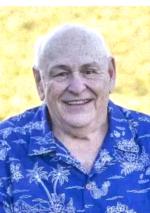
Friends Remembered
Posted: 07/208/2023
Comments: 0 |
Merv Schweigert, K9FD (SK)
Comments from Robert Nickels W9RAN, July 27, 2023: There is nothing worse for a ham radio operator than to see a beloved friends callsign with the letters "SK" behind them. Yet sadly, that's what happened on July 23, 2023, when I learned of the passsing of Merv Schweigert, K9FD. While many of our ham radio interests were different - Me... READ MORE |
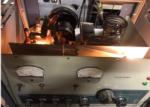
Vintage Ham Radio
Posted: 01/19/2023
Comments: 0 |
"Winter Projects"
I know many of us who enjoy restoring and repairing vintage gear look forward to winter when there is less competition for time and energy, and a chance to really make a dent in our "to be fixed" piles. A couple of years ago I set time aside for "Heathkit Singlebander Week" and went through every one of them I had, with the result that they're all working ... READ MORE |
